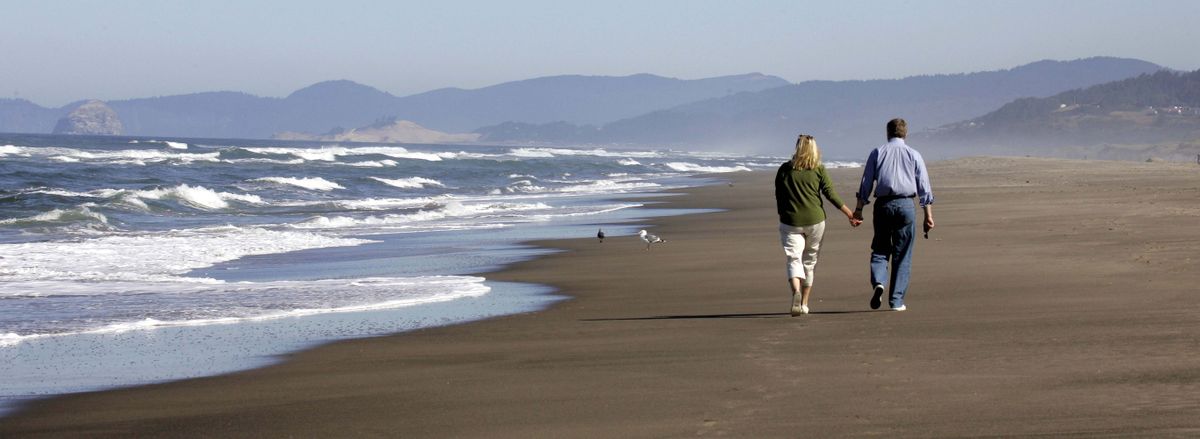A toast to the coast
Oregon’s beautiful public beaches remain uncrowded and for the most part, free

NEWPORT, Ore. – Oregon’s coast is still wild enough to be a windy wonder, tame enough for the squeamish, surprisingly affordable and uncrowded – yet diverse enough to please at least someone in the car most of the time.
All beaches are public, and access is guaranteed by law.
Because the coastal highway didn’t go in until the 1930s, much of the coast remains relatively free of commercial development and some is scarcely developed at all, although that is changing.
You can look for agates, watch whales, deep-sea fish, go crabbing, surf, play golf, explore shipwrecks and fishing fleets, hit a world-class aquarium and a family-oriented marine science center, try your luck at tribal casinos, poke around for a legendary buried treasure or sit back and watch spectacular surf pound the rocks.
Or you can just stroll the beach, feel the cool, stiff wind on your cheeks and quite possibly see only a handful of people.
Not bad. And a lot of it is free.
The 363-mile coast is dotted with small villages plus a few medium-sized cities that by and large still are blue-collar fishing towns and seaports, not yet tarted up for tourism.
Don’t try to see how fast you can make the drive. Take time to poke around and find your own favorite place or local festival.
Reasonable if not ritzy motel rooms in the $35-$50 range are common, but can vary with the season. You can pay more – a lot more – but rarely have to.
There are plenty of state parks with camping facilities ranging from the very basic to domed, cabin-like yurts. Rates vary and in the summer especially, reservations are advisable through the Oregon State Parks Department.
A downside: It might rain in the summer. It will rain in the winter.
The ho-hum miles along Oregon’s piece of U.S. 101, much of it two-lane, are more than offset by drop-dead beauty the rest of the way.
Watch out for bikes. Some hardy souls pedal the entire distance.
The drive from Portland to Astoria along the Columbia River takes about two hours. Astoria, at the river’s mouth, has become a port of call for a few cruise ships.
It’s a town that some visitors call quaint, but most residents don’t. A steep hillside of Victorian-era houses looms over what amounts to a riverfront main street lined with small, family-owned businesses.
Astoria is unpretentious, yet it has good restaurants and museums. Not to miss: the Columbia River Maritime Museum, open daily. You will learn why the nearby river’s mouth is called the “Pacific Graveyard.”
Nearby are the diminishing remains of the Peter Iredale, a four-masted barque that sits where it ran aground in 1906. There are other shipwrecks on the coast, some appearing and vanishing with the tidal patterns and winds.
Also just south of Astoria is Fort Clatsop (follow the signs), where the Lewis and Clark expedition spent the soggy winter of 1805-1806. Part of the National Park System, it contains a replica of their fort and an interpretive center and book store. Archaeologists still work the site from time to time.
Continue to Manzanita at the base of Nea-Kah-Nie Mountain, where Indian legend has it that sailors came ashore, probably in the 1700s, and buried a chest – leaving the body of one of their members slumped over it.
It’s plausible. Spanish sailing ships carrying beeswax from the Philippines to Mexico wrecked on that part of the coast, and chunks of the wax still turn up, much less often now. The best collection probably is at the Tillamook County Pioneer Museum.
While in Tillamook, visit the Tillamook cheese factory, which offers free self-guided tours.
Farther south in Newport, the historic waterfront district still keeps at least some of its old aura.
There are some good restaurants and shops featuring work of regional artisans. Oregon State University’s Hatfield Marine Science Center across the bay offers user-friendly movies, exhibits and displays of coastal marine life, including a live but wet “petting zoo” of marine creatures and educational walking tours of the fishing fleet docks. Donations are encouraged.
Nearby is the highly rated Oregon Coast Aquarium.
There are nine 19th-century lighthouses along the coast, some open to the public and many working, although automated.
Some sites are favored by surfers (with wetsuits; the water is brutally cold). Great White sharks are not unheard of.
Several ports offer salmon or other fishing charters. Newport provides boat trips to watch gray whales not far off the coast.
Between there and Florence, 50 miles to the south, is some of the more spectacular scenery on the coast.
South of Florence is the National Dunes Recreation Area, 40 miles of desert-like sand mountains. For a slow climb up and a steep romp down, try Jesse Honeyman State Park just south of town.
The southern end of the coast, too, is spectacular, if more isolated, and small towns such as Bandon and Port Orford recall a calmer era.
Many visitors to Gold Beach take the daylong Rogue River mail boat trip upriver to Agness and back. Boats have been taking mail to the isolated region since 1895.
Today, two companies offer jet-boat trips up the river, usually from May to October. Jerry’s Rogue Jets and Mail Boat Hydro-Jets are easy to find.
Rental car agencies have various drop-off options, if not farther down the coast in California then at cities inland.